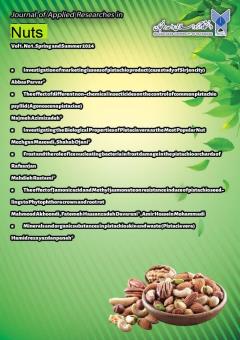Minerals and organic substances in pistachio skin and waste (Pistacia vera)
Subject Areas :
1 - عضو هیئت علمی دانشگاه آزاد اسلامی رفسنجان
Keywords: mineral and organic compounds, pistachios, waste,
Abstract :
Pistachios are one of the most important agricultural products in Iran and play an important role in the country's exports. Agricultural by-products are destroyed in different stages without being processed, and transformation industries in Iran do not take full advantage of all the components of an agricultural product. Chemical and mineral compounds are compounds that are either produced in the organs of different plants or absorbed by the plant from the environment. Pistachio shell is the main part of pistachio by-products. The presence of these compounds in pistachio leaves and skins can be used as a source for human use in industry and agriculture. In this research, the detection and measurement of organic and mineral substances in pistachio soft skins, which are produced in pistachio collection centers along with pistachio processing, and it was concluded that these substances are mostly considered as waste and waste, they can be used The identification of these substances was done with the help of usual laboratory methods and also with GC-MS method. The primary organic materials in pistachio skin include various types, about fifty percent of these materials are structural organic materials such as cellulose and pectin. Types of proteins and amino acids that are nitrogen-containing molecules. They make up about 11-15% of the volume of available materials. The share of fats is between 5 and 7 percent, and raw ash, which contains various elements, constitutes 10 percent.
1. Abrishami, M.H. 2000. Pistachio of Iran (historical knowledge). University Publishing Center of Tehran.
2. Ahmadi, Z. Mirdehghan, S.H. 2013. Secondary compounds of pistachio green skin and its beneficial effects. Olive, 226: 62-67.
3. Iran's agricultural statistics letter, 1994. Ministry of Agriculture.
4. Kafi, M., Zand, A., Kamkar, B., Sharifi, H. and Guldani, M. 2000. Plant Physiology. Publications University of Mashhad.
5. Lekha, C. and Sharma K.R. 2005. Borehole method of oleoresin tapping in chirpine (Pinus roxburghii Sargent). Forest Chemical Review, 115(3): 11-17.
6. Mehranjad, M.R. 2002. Pistachio psyllium and other important psylliums of Iran. Publications of Tehran Agricultural Research and Training Organization.
7. Mohammadi Moghadam, T., Razavi, S.M.A., Malekzadegan, F. and Shaker, A. 2018. Investigating the physico-chemical and sensory properties of pistachio green skin marmalade, Quarterly Journal of Food Science and Industry, 6(4): 1-10.
8. Rashid Mohassel, M., Rahimian, H. and Banaian, M. 1993. Weeds and their control. Academic Jihad University of Mashhad.
9. Rodrigues-Corrêa, K.C.S., Lima, J.C. and Fett-Neto, A.G. (2012) Pine Oleoresin: Tapping Green Chemicals, Biofuels, Food Protection, and Carbon Sequestration from Multipurpose Trees. Food and Energy Security, 1: 81–93.
10. Safari, M. 2001. Weeds and methods of fighting them. Kerman Academic Jihad Publications.
11. Sandra, P. and Bicchi, C. 1987. Capillary gas chromatography in essential oil analysis. Hüthig, Heidelberg, Basel, New York, 435 p.
12. Sharma O. P. 2002. Efficient resin tapping and its processing in Himachal Pradesh: An overview. Indian Forester, 128(4): 371-378.
13. Sheibani, A., Frivarmahin, H. and Ozghandi, A. 2014. Pistachio and its production in Iran. Journal of Pistachio Research Institute.


